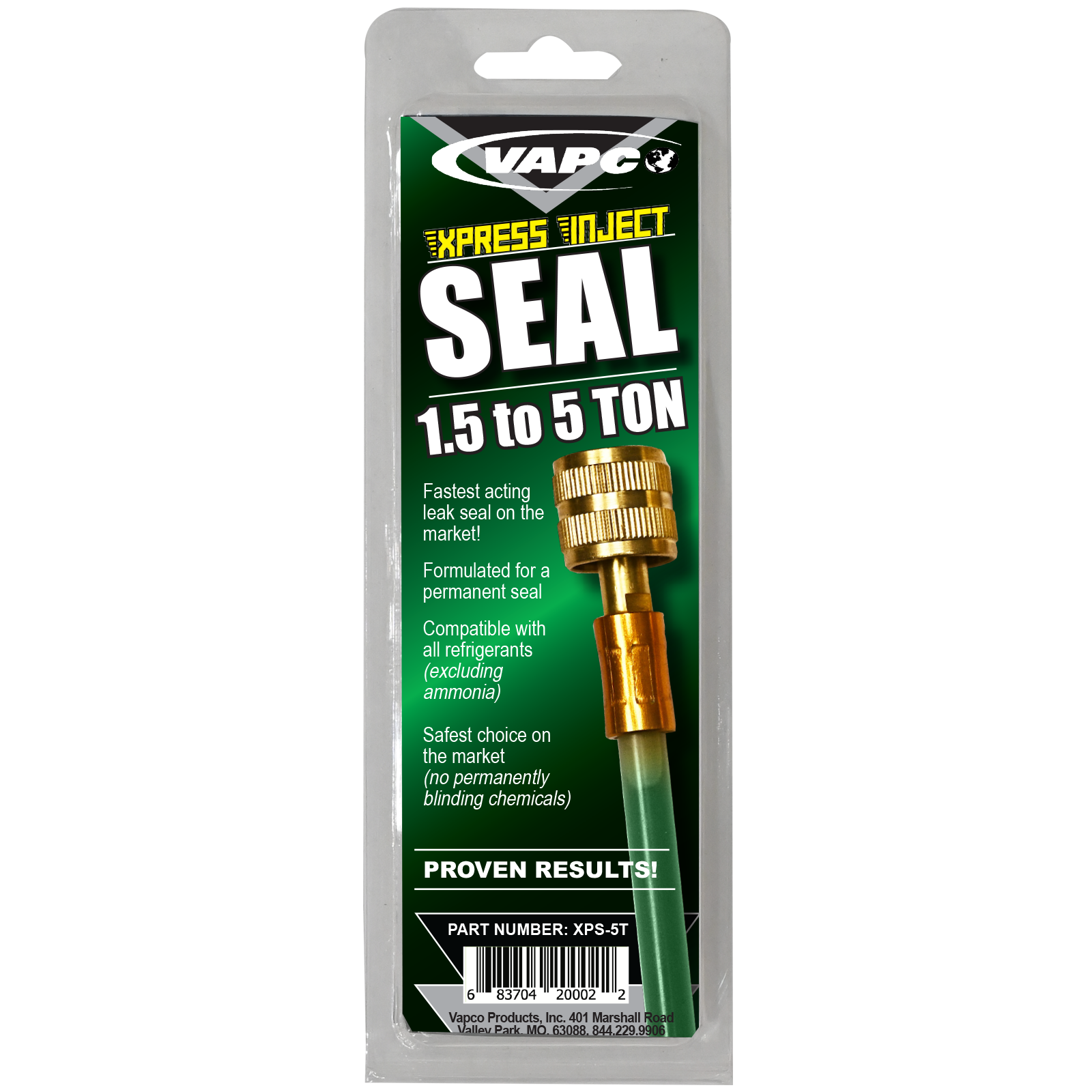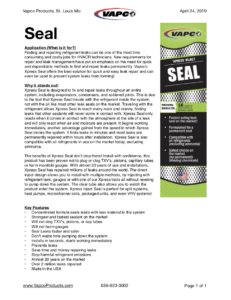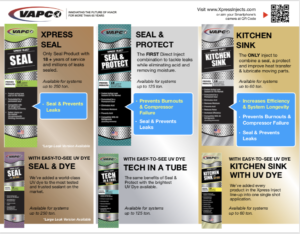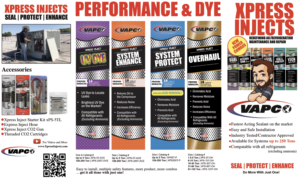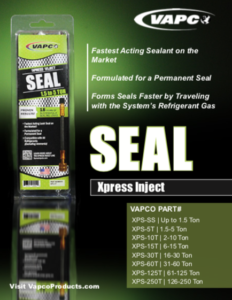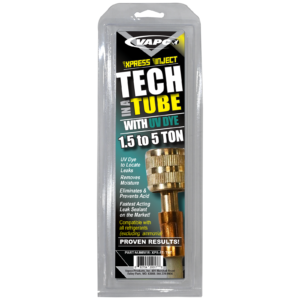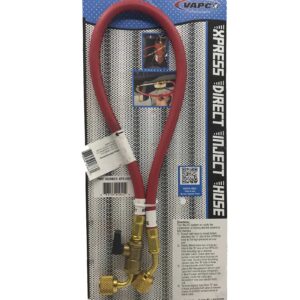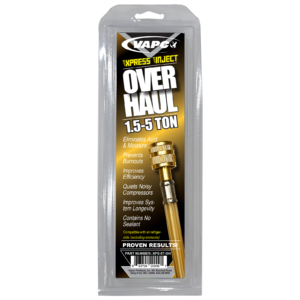XPRESS SEAL
XPRESS SEAL Refrigerant Leak Sealant — Original HVACR Formula (Since 1999)
Built specifically for HVACR service, XPRESS SEAL’s advanced formulation delivers rapid leak sealing while maintaining system efficiency. Its refrigerant-carried path provides even distribution to the entire circuit, and its non-reactive behavior inside the closed loop means it only activates at actual leak paths—helping reduce call-backs, refrigerant losses, and costly downtime across residential, light commercial, and heavy industrial applications. Xpress Seal Refrigerant leak sealant is the ideal sealant for HVACR applications, from small appliances to large industrial equipment, Vapco has the right size for any job with one tube.
Key Features and Benefits
- Travels with refrigerant, not oil: Ensures full‑circuit coverage, avoids oil‑borne deposits, and protects metering devices.
- Proven Results: Millions of leaks sealed since 1999 and still going!
- Atomizes on injection; fully compressible: Preserves compressor performance and system efficiency.
- Reacts only at real leak sites: Non-reactive inside the system; activates with pressure change, moisture, and air to seal quickly and durably. Polymer-Free technology.
- Fast, durable sealing: Targets micro-leaks to reduce refrigerant loss, improve reliability, and minimize repeat service calls.
- Broadest size range in the industry: From mini appliance systems to 60‑ton commercial and industrial units.
- Wide refrigerant compatibility: Works with all refrigerants used in HVACR except ammonia systems. A2L compatible.
- Pro‑grade convenience: Designed for efficient field installation and rapid return-to-service.
Part Number
- XPS-MINI Appliances – 6/cs
- XPS-SS Up to 1.5 Ton – 6/cs
- XPS-5T 1.5-5 Ton – 6/cs
- XPS 10T 2-10 Ton – 4/cs
- XPS-15T 6-15 Ton – 4/cs
- XPS-30T 16-30 Ton – 4/cs
- XPS-60T 31-60 Ton – 4/cs
- ACCESSORIES – (NOT REQUIRED)
Xpress Seal Refrigerant Leak Sealant Directions:
This product must be used in accordance with the following directions and by professionals only.
Always read the product label and Safety Data Sheet (SDS) for complete precautionary and first aid information before use.
XPRESS SEAL is designed for quick and effective leak sealing in HVACR systems. Choose the method below that best suits your equipment and job site conditions.
General Safety & Pre-Installation Checks (Applicable to All Methods)
Before beginning, ensure the system is ready and you have the correct XPRESS SEAL product for the system’s tonnage.
- Safety First: Always wear appropriate personal protective equipment (PPE), including safety glasses and protective gloves, when working with refrigerants and sealants.
- Identify Ports: Clearly identify the low-side (suction) and high-side (liquid) service ports on the system.
- System Running & Mode:
- Ensure the HVACR system is powered on and running, with the compressor engaged.
- If working on a heat pump, set the system to Cooling Mode for optimal sealant distribution.
- System Charge: Verify the system has an adequate refrigerant charge. XPRESS SEAL can be injected into a fully charged or partially low system; if significantly low, you may use refrigerant to push the sealant (see Traditional Method alternative).
- Refrigerant Compatibility: Confirm the system is NOT an ammonia (NH3) system, as XPRESS SEAL is not compatible.
- XPRESS SEAL Size: Ensure you have selected the appropriate XPRESS SEAL cartridge size for the system’s tonnage (e.g., XPS-Mini, XPS-5T, XPS-60T).
- Inspect XPRESS SEAL Tube: Do not bend, cut, or deform the tube. Check to ensure small nitrogen bubble is present and free moving in the tube.
Traditional Manifold-Assisted High-Side System Pressure Injection (into Low-Side)
This method uses your manifold gauge set and the system’s own high-side pressure to push XPRESS SEAL into the low-pressure side of the system.
- Prepare System & Ports:
- Ensure system is running with the compressor engaged
- Important: If system is a heat pump, set it to cooling before proceeding.
- Identify both the low-side (suction) and high-side (liquid) service ports.
- Check Injector Compatibility
- Condition: Preform only if your vavle core is too deep to be engaged by the Xpress Inject tube.
- Action: To fix, turn the depressor on your Xpress Inject counterclockwise (max 1 turn) until you confirm it properly engages the system’s valve core.
- Connect Xpress Inject: LOOSELY Connect the Xpress Inject tube (containing the sealant) to the low-side service port. Will complete connection after purge of manifold hoses.
- Prepare Manifold:
- Ensure both the high-side (red) and low-side (blue) valves on your manifold gauge set are COMPLETELY CLOSED.
- Attach your high-pressure (red) manifold hose to the system’s high-side (liquid) service port.
- Attach your low-pressure (blue) manifold hose to the XPRESS Inject tube connected at the low-side service port.
- Purge Manifold Hose:
- Quickly crack open and close the high-side (red) manifold valve to allow a small amount of high-pressure refrigerant to purge air out of the low-side (blue) hose.
- Then, close the high-side (red) manifold valve.
- Securely tighten the Xpress Inject onto the low side service port.
- Inject XPRESS SEAL:
- Slowly open the high-side (red) valve on your manifold.
- Then, slowly open the low-side (blue) manifold valve. High-pressure refrigerant from the system’s high-side will flow through your manifold and push the XPRESS SEAL from the tube into the system’s low side.
- Watch the XPRESS Inject tube: the system’s suction pressure will draw the sealant into the system. Continue until the tube is clear of sealant.
- Close & Disconnect
- Once the XPRESS Inject tube is empty and clear, close the low-side (blue) manifold valve.
- Close the high-side (red) manifold valve.
- Disconnect your manifold hose from the XPRESS Inject.
- Disconnect the XPRESS Inject from the service port. Discard or recycle the empty XPRESS Inject tube responsibly.
- Finalize: Install the service port cap securely.
- Let system run for at least 1 hour to ensure distribution of sealant throughout the system.
Alternate Injection Method: Refrigerant Tank Assisted (Low-Side)
As an alternative to using the system’s high-side pressure, you can use a refrigerant tank to assist injection.
If using this method, ensure your manifold’s low-side hose is connected to the XPRESS Inject, and the center yellow hose is connected to a refrigerant supply tank. Purge the yellow hose. Open the refrigerant tank, then slowly open the low-side (blue) manifold valve. The refrigerant pressure from the tank, combined with system suction, will push the sealant in. Close the low-side valve, then the tank, and disconnect as above.
Post-Injection Best Practices (Applicable to All Methods)
After injecting XPRESS SEAL, it’s crucial to allow the product to fully circulate and activate:
- Run Time: Run the AC unit for a minimum of one (1) hour immediately after injecting XPRESS SEAL. This ensures thorough circulation of the sealant throughout the system. For larger systems or very cold conditions, allow for even longer run times (e.g., 2-4 hours).
- System Monitoring: Monitor the system’s operating pressures and temperatures. XPRESS SEAL is designed not to alter system performance or clog metering devices.
- Leak Verification: After the recommended run time, verify leak resolution using standard diagnostic methods.
- Documentation: Document the application of XPRESS SEAL in the system’s service log, including date, product size, and method used.
Important Notes for Professionals
- Refrigerant Charging Concurrent with Sealant: If the system is low on refrigerant, XPRESS SEAL can be injected concurrently with refrigerant charging. Simply connect the XPRESS Inject to the service port and push the sealant into the system using the refrigerant being added, following the appropriate method.
- No Pump Down Required: XPRESS SEAL does not require pumping down the system for injection, regardless of refrigerant type.
- Polymer-Free Formulation: XPRESS SEAL is formulated to be “polymer free” while in the tube and circulating through the system, protecting sensitive system components.
Contact Us
News and Updates
Subscribe on Youtube
Follow Us on Facebook
SDS

________________________________________________
Vapco Products Xpress Seal Direct Inject XPS-MINI, SS, 5T, 10T, 15T, 30T, 60T
1. PRODUCT AND COMPANY IDENTIFICATION
Product Identifier: Vapco Products Xpress Seal Direct Inject XPS-MINI, SS, 5T, 10T, 15T, 30T, 60T
Product Use: A/C Sealant
Supplier Details: Vapco Products 401 Marshall Rd Valley Park, MO 63088
- Emergency: Chemtel
- Contact: 1-800-255-3924
- Phone: 636-923-2121
- Fax: 636-923-3002
- Email: [email protected]
- Web: http://www.vapcoproducts.com
2. HAZARDS IDENTIFICATION
Classification of the substance or mixture
GHS Classification in accordance with 29 CFR 1910 (OSHA HCS):
- Health, Aspiration hazard, 1
- Physical, Flammable Liquids, 2
- Health, Skin corrosion/irritation, 2
- Environmental, Hazards to the aquatic environment – Acute, 2
GHS Label elements, including precautionary statements
GHS Signal Word: DANGER
GHS Hazard Pictograms:

GHS Hazard Statements:
- H304 –May be fatal if swallowed and enters airways
- H225 – Highly flammable liquid and vapor
- H315 – Causes skin irritation
- H401- Toxic to aquatic life
GHS Precautionary Statements:
- P202 – Do not handle until all safety precautions have been read and understood.
- P210 – Keep away from heat/sp·arks/open flames/hot surfaces. No smoking P260 – Do not breathe dust/fume/gas/mist/vapors/spray.
- P264 – Wash hands and arms thoroughly after handling.
- P271 – Use _ only outdoors or in a well-ventilated area.
- P273 – Avoid release to the environment.
- P280 – Wear protective gloves/protective clothing/eye protection/face protection.
- P301+310- IF SWALLOWED: Immediately call a POISON CENTER or doctor/physician.
- P303+361 +353 – IF ON SKIN (or hair): Remove/Take off immediately all contaminated clothing. Rinse skin with water/shower.
- P304+340- IF INHALED: Remove victim to fresh air and keep at rest in a position comfortable for breathing.
- P308+313 – IF exposed or concerned: Get medical advice/attention.
- P321 – Specific treatment (see Section 4 on this SDS).
- P331 – Do NOT induce vomiting.
- P332+313 – If skin irritation occurs: Get medical advice/attention.
- P362 – Take off contaminated clothing and wash before reuse.
- P370+378- In case of fire: Use dry chemical for extinction.
- P403+235 – Store in a well ventilated place. Keep cool.
- P501 – Dispose of contents/container according to local/state/federal regulations.
3. COMPOSITION/INFORMATION ON INGREDIENTS
Ingredients:
Cas# % Chemical Name
64-17-5 2-25% Ethyl alcohol
108-88-3 <1% Toluene
78-08-0 20-75% Silane, ethenyltriethoxy
4. FIRST AID MEASURES
Inhalation: When symptoms occur: go into open air and ventilate suspected area. Immediately call a POISON CENTER or doctor/physician.
Skin Contact: Get immediate medical attention.
Eye Contact: Rinse cautiously with water for several minutes. Remove contact lenses, if present and easy to do. Continue rinsing. Immediately call a POISON CENTER or doctor/physician.
Ingestion: Do not induce vomiting. Immediately call a POISON CENTER or doctor/physician.
5. FIRE FIGHTING MEASURES
5.1. Extinguishing Media Suitable Extinguishing Media: Dry chemical powder, alcohol-resistant foam, carbon dioxide (CO2). Unsuitable Extinguishing Media: Do not use a heavy water stream. Use of heavy stream of water may spread fire.
5.2. Special Hazards Arising From the Substance or Mixture Fire Hazard: Flammable liquid. Explosion Hazard: Heat may build pressure, rupturing closed containers, spreading fire and increasing risk of burns and injuries. Reactivity: May explode if heated. Reacts with strong oxidants causing fire and explosion hazard.
5.3. Advice for Firefighters Precautionary Measures Fire: Exercise caution when fighting any chemical fire. Firefighting instructions: In case of fire: Evacuate area. Fight fire remotely due to the risk of explosion. Use water spray or fog for cooling exposed containers.
Protection During Firefighting: Do not enter fire area without proper protective equipment, including respiratory protection.
6. ACCIDENTAL RELEASE MEASURES
6.1. Personal Precautions, Protective Equipment and Emergency Procedures General Measures: Use special care to avoid static electric charges. Keep away from open flames, hot surfaces and sources of ignition. No smoking. Do not get in eyes, on skin, or on clothing. Do not breathe gas.
6.1.1. For Non-emergency Personnel Protective Equipment: Use appropriate personal protection equipment (PPE). Emergency Procedures: Evacuate unnecessary personnel. Eliminate ignition sources.
6.1.2. For Emergency Responders Protective Equipment: Equip cleanup crew with proper protection. Emergency Procedures: Stop leak if safe to do so. Ventilate area.
6.2. Environmental Precautions Avoid release to the environment.
6.3. Methods and Material for Containment and Cleaning Up For Containment: Stop leak without risks if possible. Do not take up in combustible material such as: saw dust or cellulosic material. Methods for Cleaning Up: Contact competent authorities after a spill.
6.4. Reference to Other Sections See heading 8, Exposure Controls and Personal Protection.
7. HANDLING AND STORAGE
Handling Precautions:
Handling Precautions:
7.1. Precautions for Safe Handling: Ensure there is adequate ventilation. Hygiene Measures: Handle in accordance with good industrial hygiene and safety procedures. Wash hands and other exposed areas with mild soap and water before eating, drinking, or smoking.
Storage Requirements:
7.2. Conditions for Safe Storage, Including Any Incompatibilities Technical Measures: Comply with applicable regulations. Keep at temperatures below 52° C / 125° F. Storage Conditions: Store in a dry, cool and well-ventilated place. Store locked up. – Incompatible Products: Heat sources and oxidizers.
8, EXPOSURE CONTROLS/PERSONAL PROTECTION
Engineering Controls: Personal Protective Equipment: Emergency eye wash fountains and safety showers should be available in the immediate vicinity of any potential exposure. Ensure all national/local regulations are observed.
Ethyl alcohol (64-17-5) [2-25%]
Personal protective equipment:
Eye/face protection: Face shield and safety glasses Use equipment for eye protection tested and approved under appropriate government standards such as NIOSH (US) or EN 166(EU).
Skin protection: Handle with gloves. Gloves must be inspected prior to use. Use proper glove removal technique (without touching gloves outer surface) to avoid skin contact with this product. Dispose of contaminated gloves after use in accordance with applicable laws and good laboratory practices. Wash and dry hands.
Full contact: Material: butyl-rubber Minimum layer thickness: 0.3 mm Break through time: 480 min Material tested: Butoject (KCL 897 / Aldrich 2677647, Size M)
Splash contact: Material: Nitrile rubber Minimum layer thickness: 0.2 mm Break through time: 38 min Material tested: Dermatril P (KCL 743 / Aldrich 2677388, Size M) data source: KCL GmbH, D-36124 Eichenzell, phone +49 (0)6659 87300, e-mail [email protected], test method: EN374 If used in solution, or mixed with other substances, and under conditions which differ from EN 374, contact the supplier of the CE approved gloves. This recommendation is advisory only and must be evaluated by an industrial hygienist and safety officer familiar with the specific situation of anticipated use by our customers. It should not be construed as offering an approval for any specific use scenario.
Body Protection: impervious clothing, Flame retardant antistatic protective clothing, The type of protective equipment must be selected according to the concentration and amount of the dangerous substance at the specific workplace.
Respiratory protection: Where risk assessment shows air-purifying respirators are appropriate use a full-face respirator with multi- purpose combination (US) or type ABEK (EN 14387) respirator cartridges as a backup to engineering controls. If the respirator is the sole means of protection, use a full-face supplied air respirator. Use respirators and components tested and approved under appropriate government standards such as NIOSH (US) or CEN (EU).
Control of environmental exposure: Prevent further leakage or spillage if safe to do so. Do not let product enter drains.
Toluene (108-88-3) [<1%]
Personal protective equipment Eye/face protection: Face shield and safety glasses Use equipment for eye protection tested and approved under appropriate government standards such as NIOSH (US) or EN 166(EU).
Skin protection: Handle with gloves. Gloves must be inspected prior to use. Use proper glove removal technique (without touching gloves outer surface) to avoid skin contact with this product. Dispose of contaminated gloves after use in accordance with applicable laws and good laboratory practices. Wash and dry hands. Page 3of 10 Ethyl alcohol {64-17-5) [2-25%]
Full contact: Material: Fluorinated rubber Minimum layer thickness: 0. 7 mm Break through time: 480 min Material tested: Vitoject (KCL 890 / Aldrich 2677698, Size M)
Splash contact: Material: Fluorinated rubber Minimum layer thickness: 0.7 mm Break through time: 480 min Material tested: Vitoject (KCL 890 / Aldrich 2677698, Size M) data source: KCL GmbH, D-36124 Eichenzell, phone +49 (0)6659 87300, e-mail [email protected], test method: EN374 If used in solution, or mixed with other substances, and under conditions which differ from EN 374, contact the supplier of the CE approved gloves. This recommendation is advisory only and must be evaluated by an industrial hygienist and safety officer familiar with the specific situation of anticipated use by our customers. It should not be construed as offering an approval for any specific use scenario.
Body Protection: Complete suit protecting against chemicals, Flame retardant antistatic protective clothing, The type of protective equipment must be selected according to the concentration and amount of the dangerous substance at the specific workplace.
Respiratory protection: Where risk assessment shows air-purifying respirators are appropriate use a full-face respirator with multi- purpose combination (US) or type ABEK (EN 14387) respirator cartridges as a backup to engineering controls. If the respirator is the sole means of protection, use a full-face supplied air respirator. Use respirators and components tested and approved under appropriate government standards such as NIOSH (US) orCEN (EU).
Control of environmental exposure: Prevent further leakage or spillage if safe to do so. Do not let product enter drains. Discharge into the environment must be avoided.
Silane, ethenyltriethoxy- {78-08-0) (20-75%]
Personal protective equipment
Respiratory protection: Where risk asses.sment shows air-purifying respirators are appropriate use a full-face respirator with multi-purpose combination (US) or type ABEK (EN 14387) respirator cartridges as a backup to engineering controls. If the respirator is the sole means of protection, use a full-face supplied air respirator. Use respirators and components tested and approved under appropriate government standards such as NIOSH (US) orCEN (EU).
Hand protection: Handle with gloves. Gloves must be inspected prior to use. Use proper glove removal technique (without touching gloves outer surface) to avoid skin contact with this product. Dispose of contaminated gloves after use in accordance with applicable laws and good laboratory practices. Wash and dry hands. Full contact Material: Nitrile rubber Minimum layer thickness: 0.4 mm Break through time: 480 min Material tested:Camatril (KCL 730 / Aldrich 2677442, Size M) Splash contact data source: KCL GmbH, D-36124 Eichenzell, phone +49 (0)6659 87300, e-mail [email protected], test method: EN374 If used in solution, or niixed with other substances, and under conditions which differ from EN 374, contact the supplier of the CE approved gloves. This recommendation is advisory only and must be evaluated by an industrial hygienist and safety officer familiar with the specific situation of anticipated use by our customers. It should not be construed as offering an approval for any specific use scenario.
Eye protection: Face shield and safety glasses Use equipment for eye protection tested and approved under appropriate government standards such as NIOSH (US) or EN 166(EU).
Skin and body protection: impervious clothing, Flame retardant antistatic protective clothing, The type of protective equipment must be selected according to the concentration and amount of the dangerous substance at the specific workplace.
Hygiene measures: Handle in accordance with good industrial hygiene and safety practice. Wash hands before breaks and at the end of workday.

